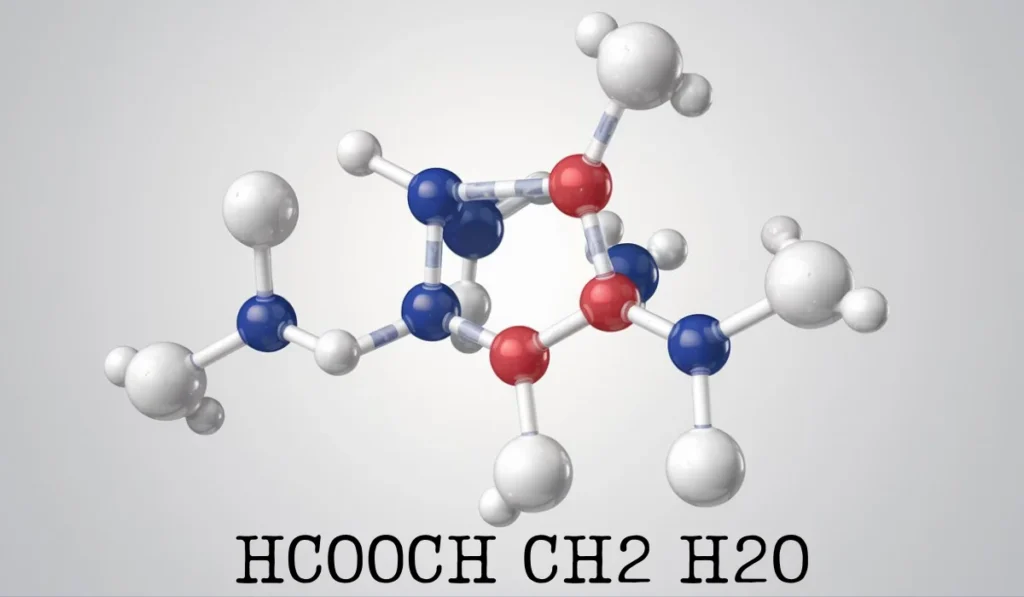Introduction
HCOOCH CH₂ H₂O, Chemistry offers a rich language to describe matter and the transformations it undergoes. Among the many formulas and symbols, some stand out due to their recurring use in reactions, applications, or theory. In this article, we’ll explore three specific chemical components — HCOOCH (methyl formate), CH₂ (methylene), and H₂O (water). Each plays a vital role in chemical synthesis, industry, and daily life.
This article dissects their individual properties, examines their applications, analyzes their behavior when they undergo reaction, and illustrates how they interact with each other within various contexts of science.
Chapter 1: What is HCOOCH — Methyl Formate?
1.1 What is Methyl Formate?
Methyl formate, or HCOOCH₃, is an ester produced by combining formic acid (HCOOH) and methanol (CH₃OH). It is fragrant and has a fruity odor and is utilized in perfumes, solvents, and chemical synthesis.
1.2 Structure and Properties
- Chemical formula: HCOOCH₃
- Molecular weight: 60.05 g/mol
- Boiling point: 31.5°C
- Solubility: Slightly soluble in water
- Appearance: Colorless liquid
It has an ester functional group (-COO-) that determines its reactivity and classification.
1.3 Industrial Uses
Methyl formate is not just a compound with a nice smell. It’s utilized in various ways:
Solvent in quick-drying finishes
Intermediate in formamide, dimethylformamide production
Blowing agent in producing polyurethane foams
It has a balance of reactivity and safety, thus it is a useful compound in industry.
1.4 Methyl Formate Reactions
Methyl formate has a few important reactions:
Hydrolysis under acidic or basic conditions to give methanol and formic acid
Reduction under hydrogen in the presence of catalysts to give methanol
Carbonylation reactions to produce higher esters or acids
Chapter 2: CH₂ — The Reactive Methylene Group
2.1 What is CH₂
CH₂, or methylene, is a carbon atom attached to two hydrogens. It may be:
A component of longer alkanes or alkenes
A reactive carbene species (when in the form :CH₂)
A methylene bridge between polymers and organic compounds
2.2 The Methylene Bridge
In organic structures, CH₂ units tend to connect functional groups or construct carbon chains. For instance:
Alkanes such as propane (CH₃-CH₂-CH₃) contain CH₂ as the core group
Polymers such as polyethylene are made up of repetitive CH₂ units
These moieties are responsible for the structure, flexibility, and stability of the molecule.
2.3 CH₂ as a Carbene (:CH₂)
When methylene is a carbene, it is very reactive. It inserts into C-H bonds or forms cyclopropanes with alkenes. Singlet and triplet CH₂ have contrasting reactivity patterns.
2.4 Reactions and Applications
Reactive CH₂ species participate in:
Cyclopropanation reactions (e.g., Simmons–Smith reaction)
Insertions into single or double bonds
Intermediates in photochemical or thermal reactions
Methylene bridges play a critical role in biological molecules, e.g., methylene tetrahydrofolate utilized in the synthesis of DNA.
Chapter 3: H₂O — The Universal Solvent
3.1 Water in Chemistry
Water, H₂O, is more than just something we drink. It’s the most significant solvent in both laboratory and industrial chemistry.
- Molecular structure: Bent, 104.5° bond angle
- Polarity: High dipole moment
- Hydrogen bonding: Account for its distinctive properties
Water is capable of dissolving a great variety of substances because of its polarity, and it is required in reactions, separation, and analysis.
3.2 Physical and Chemical Properties
- Boiling point: 100°C
- Melting point: 0°C
- Density: 1 g/cm³ at 4°C
- pH: 7 (neutral under normal conditions)
The high heat capacity and surface tension of water enable it to regulate temperature changes and sustain life.
3.3 Water in Reactions
Water serves numerous functions in chemical reactions:
- Reactant in hydrolysis and hydration
- Solvent in acid-base and redox reactions
- Product in combustion and condensation
Water commonly features in equilibrium reactions in organic chemistry, where the removal or addition of water changes the direction of the reaction.
Chapter 4: Interactions and Relevance in Organic Chemistry
4.1 HCOOCH and H₂O: Hydrolysis Reaction
Under acidic or basic conditions, methyl formate decomposes when reacted with water to form formic acid (HCOOH) and methanol (CH₃OH).
Reaction:
HCOOCH₃ + H₂O → HCOOH + CH₃OH
This reverse reaction shows how water hydrolyzes ester bonds, which is a key step in both the lab and digestion.
4.2 CH₂ and H₂O: Alkenes Hydration
CH₂ fragments occur in alkenes. Alkenes react with water to give alcohols.
Example:
CH₂=CH₂ + H₂O → CH₃CH₂OH (ethanol)
This is a case of Markovnikov addition, acid-catalyzed.
4.3 Combining All Three: Industrial Synthesis Routes
In industrial scale-up, chemical engineers might be faced with systems containing all three:
- Water as a byproduct or solvent
- Methyl formate as an intermediate
- CH₂ units of target molecules or transition states
Such is the case in the preparation of formaldehyde from methanol, wherein methyl formate serves as an intermediate. Side reactions and product purification sometimes involve water.
Chapter 5: Role in the Environment and Biochemistry
5.1 Water: Basis of Life
No description is complete without referring to water’s role in life:
- Maintains temperature
- Facilitates biochemical reactions
- Sustains ecosystems
It serves as the enzyme medium, the pH regulator, and the foundation of food chains.
5.2 Esters such as HCOOCH in Nature
Methyl formate and other such esters occur in:
- Fruits
- Flowers
- Fermentation processes
These molecules usually provide flavor and scent.
5.3 CH₂ Groups in Biology
Numerous biological molecules have CH₂ units:
- Fatty acids
- Amino acids
- DNA backbones
The carbon-hydrogen bond of CH₂ is quite stable, yet enzymes will selectively modify them for energy or build-up.
Chapter 6: Safety, Storage, and Environmental Impact
6.1 Safety Considerations
Methyl formate is flammable. Use with care in well-ventilated locations.
Water is safe but can promote corrosion or react with active metals.
CH₂ (carbenes) are unstable and should be dealt with only under expert guidance.
6.2 Environmental Impacts
Methyl formate breaks down in the atmosphere but should be kept from reaching groundwater.
CH₂ intermediates have a very short life cycle and typically are dealt with in controlled environments.
Water pollution is a significant problem all over the world. Ensuring water quality is critical.
Chapter 7: Applications and Future Directions
7.1 Research and Development
- Researchers utilize these compounds for:
- Green chemistry breakthroughs
- Biodegradable products
- Alternative fuels
Methyl formate is considered for replacing CFCs because it is non-toxic and less volatile.
7.2 Education and Learning
These molecules are very good teaching materials in:
- Organic chemistry
- Environmental science
- Chemical engineering
By examining their structure and reactivity, students develop an understanding of more general concepts such as reaction mechanisms, polarity, and thermodynamics.
7.3 Industrial Innovation
Industries depend on such compounds to:
Develop new solvents and intermediates
Design more efficient reaction pathways
Design environmentally friendly products
Conclusion
HCOOCH, CH₂, and H₂O look deceptively simple on the surface, but they capture fundamental concepts of organic chemistry. All three compounds have distinct properties, functions, and demands. Whether you’re creating reactions, learning biochemistry, or collaborating in environmental studies, insight into these molecules enables you to construct a solid chemical foundation.
Their separate purposes and combined interactions provide implications that advance innovation, education, and sustainability.



